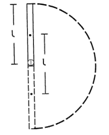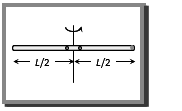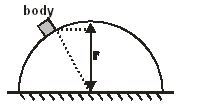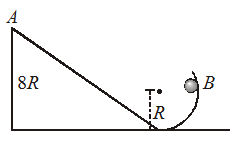12th Grade > Physics
ROTATION ROCK AND ROLL MCQs
Total Questions : 30
| Page 1 of 3 pages
Answer: Option A. -> 2r3
:
A
Let normal reaction makes an angle θfrom vertical, then v2=2gr(1−cosθ) and mv2r=mgcosθ ⇒height from ground h=2r3
:
A
Let normal reaction makes an angle θfrom vertical, then v2=2gr(1−cosθ) and mv2r=mgcosθ ⇒height from ground h=2r3
Question 2. A uniform rod of mass 'm' and length 'l' is kept vertical with the lower end clamped. It is slightly pushed to let it fall down under gravity. Find its angular speed when the rod is passing through its lowest position. Neglect any friction at the clamp. What will be the linear speed of the free end at this instant?
Answer: Option A. -> √6gl,√6gl
:
A

As the rod reaches its lowest position, the centre of mass is lowered by a distance l. Its gravitational potential energy is decreased by mgl. As no energy is lost against friction, this should be equal to the increase in the kinetic energy. As the rotation occurs about the horizontal axis through the clamped end, the moment of inertia is I = ml2/3. Thus,
12Iω2=mgl
12(ml23)ω2=mgl
or ω=√6gl.
The linear speed of the free end is
V=Iω=√6gl.
:
A
As the rod reaches its lowest position, the centre of mass is lowered by a distance l. Its gravitational potential energy is decreased by mgl. As no energy is lost against friction, this should be equal to the increase in the kinetic energy. As the rotation occurs about the horizontal axis through the clamped end, the moment of inertia is I = ml2/3. Thus,
12Iω2=mgl
12(ml23)ω2=mgl
or ω=√6gl.
The linear speed of the free end is
V=Iω=√6gl.
Answer: Option D. -> None of these
:
D
When solid sphere rolls down an inclined plane the velocity at bottom v1=√107gh
but, if there is no friction then it slides on inclined plane and the velocity at bottom v2=√2gh
∴v1v2=√57.
:
D
When solid sphere rolls down an inclined plane the velocity at bottom v1=√107gh
but, if there is no friction then it slides on inclined plane and the velocity at bottom v2=√2gh
∴v1v2=√57.
Answer: Option A. -> [10gR]1/2
:
A
Applying the conservation of energy at points A and B, we have
mg(8R)=mv22+12Iω2+mgR
or mg(8R)=mv22+12(25mR2)(vR)2+mgR
=710mv2+mgR
mg(8R−R)=710mv2
[10gR]1/2
:
A
Applying the conservation of energy at points A and B, we have
mg(8R)=mv22+12Iω2+mgR
or mg(8R)=mv22+12(25mR2)(vR)2+mgR
=710mv2+mgR
mg(8R−R)=710mv2
[10gR]1/2
Answer: Option A. -> d⃗Ldt is perpendicular to ⃗L at all times.
:
A
Due to law of conservation of angular momentum, ⃗L= constant
i.e. ⃗L.⃗L = constant
or, ddt(⃗L.⃗L)=0
or, 2⃗L.d⃗Ldt=0
or, ⃗L⊥d⃗Ldt
Since τ=⃗A×⃗L
d⃗Ldt=⃗A×⃗L
i.e., d⃗Ldt must be perpendicular to ⃗A as well as ⃗L.
Further the component of ⃗L along ⃗A is ⃗A.⃗LA. Also
ddt(⃗A.⃗L)=⃗A.d⃗Ldt+⃗L.d⃗Adt=0 {∵⃗A⊥d⃗Ldtandd⃗Adt=⃗0}
or, ⃗A.⃗L = constant
i.e., ⃗A.⃗LA = x = constant
Since d⃗Ldt(orτ) is perpendicular to ⃗L, hence it cannot change magnitude of ⃗L but can surely change direction of ⃗L.
:
A
Due to law of conservation of angular momentum, ⃗L= constant
i.e. ⃗L.⃗L = constant
or, ddt(⃗L.⃗L)=0
or, 2⃗L.d⃗Ldt=0
or, ⃗L⊥d⃗Ldt
Since τ=⃗A×⃗L
d⃗Ldt=⃗A×⃗L
i.e., d⃗Ldt must be perpendicular to ⃗A as well as ⃗L.
Further the component of ⃗L along ⃗A is ⃗A.⃗LA. Also
ddt(⃗A.⃗L)=⃗A.d⃗Ldt+⃗L.d⃗Adt=0 {∵⃗A⊥d⃗Ldtandd⃗Adt=⃗0}
or, ⃗A.⃗L = constant
i.e., ⃗A.⃗LA = x = constant
Since d⃗Ldt(orτ) is perpendicular to ⃗L, hence it cannot change magnitude of ⃗L but can surely change direction of ⃗L.
Question 6. A smooth sphere A is moving on a frictionless horizontal plane with angular speed ω and centre of mass is moving translationally with velocity 'v'. It collides elastically and head-on with an identical sphere B which is at rest. All surfaces are frictionless. After the collision, their angular speeds are ωA and ωB, respectively. Then,
Answer: Option A. -> ωB=0
:
A
ωB=0rotational KE can’t be transferred from A to B as surfaces are frictionless.
:
A
ωB=0rotational KE can’t be transferred from A to B as surfaces are frictionless.
Question 7. A smooth uniform rod of length 'L' and mass 'M' has two identical beads of negligible size, each of mass 'm', which can slide freely along the rod. Initially the two beads are at the centre of the rod and the system is rotating with angular velocity ω0 about an axis perpendicular to the rod and passing through the mid point of the rod (see figure). There are no external forces. When the beads reach the ends of the rod, the angular velocity of the system is


Answer: Option D. -> Mω0M+6m
:
D
Since there are no external forces therefore the angular momentum of the system remains constant.
Initially when the beads are at the centre of the rod angular momentum L1=(ML212)ω0 .....(i)
When beads reach the ends of the rod then angular momentum =(m(L2)2+m(L2)2+ML212)ω′
..(ii) Equating (i) and (ii) ML212ω0=(mL22+ML212)ω′⇒ω′=Mω0M+6m.
:
D
Since there are no external forces therefore the angular momentum of the system remains constant.
Initially when the beads are at the centre of the rod angular momentum L1=(ML212)ω0 .....(i)
When beads reach the ends of the rod then angular momentum =(m(L2)2+m(L2)2+ML212)ω′
..(ii) Equating (i) and (ii) ML212ω0=(mL22+ML212)ω′⇒ω′=Mω0M+6m.
Answer: Option A. -> 1.4 m/sec
:
A
v=√2gh1+k2R2=√2×9.8×lsinθ1+25[Ask2R2=25,l=hsinθandsinθ=110given]
⇒v=√2×9.8×1.4×11075=1.4m/s.
:
A
v=√2gh1+k2R2=√2×9.8×lsinθ1+25[Ask2R2=25,l=hsinθandsinθ=110given]
⇒v=√2×9.8×1.4×11075=1.4m/s.
Answer: Option C. -> 10.3 rad/s
:
C
Initial angular momentum of bullet + initial angular momentum of cylinder
= Final angular momentum of (bullet + cylinder) system
⇒mvr+I1ω=(I1+I2)ω′
⇒mvr+I1ω=(12Mr2+mr2)ω′
⇒0.5×5×0.2+0.12=(122(0.2)2+(0.5)(0.2)2)ω′
∴ω′=10.3rad/sec.
:
C
Initial angular momentum of bullet + initial angular momentum of cylinder
= Final angular momentum of (bullet + cylinder) system
⇒mvr+I1ω=(I1+I2)ω′
⇒mvr+I1ω=(12Mr2+mr2)ω′
⇒0.5×5×0.2+0.12=(122(0.2)2+(0.5)(0.2)2)ω′
∴ω′=10.3rad/sec.
Answer: Option B. -> √2mghI+mr2
:
B
According to law of conservation of energy mgh=12(I+mr2)ω2⇒ω=√2mghI+mr2.
:
B
According to law of conservation of energy mgh=12(I+mr2)ω2⇒ω=√2mghI+mr2.


















